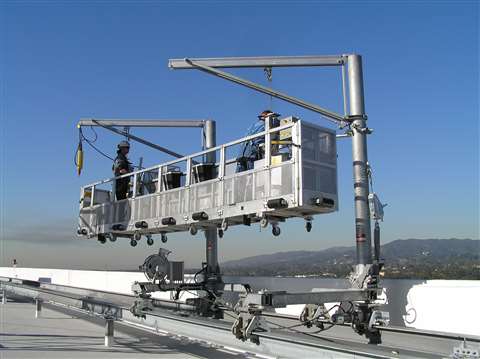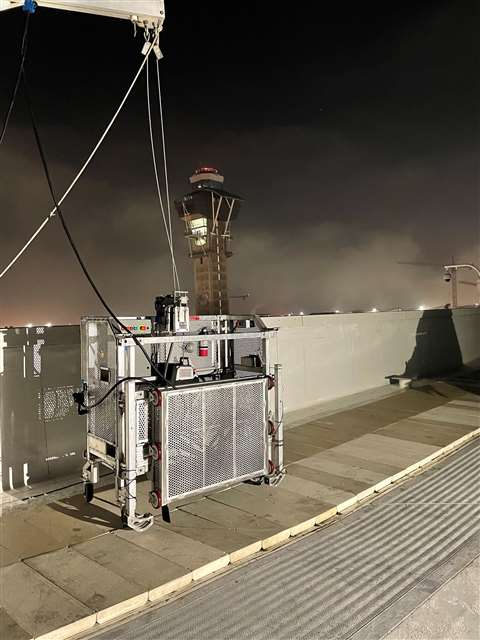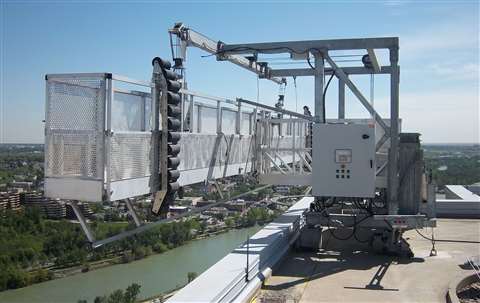PI 101: Permanent installed platforms, cradles, gondolas
01 July 2022
As discussed in the last Permanent Installation (PI) Council article, one portion of a PI system is the suspended platform. Suspended platforms fall into two categories, temporary (transportable) platforms and permanently installed (pi) platforms (platforms dedicated to the building/structure). Either platform type may be used with a specific permanent installation support system such as davits. All PI platforms must be inspected before use and have passed all initial and periodic testing noted in OSHA 1910.66 and ANSI A120. In this article, we will be focusing on the two different types of permanently installed platforms: self-powered permanently installed platforms and roof-powered permanently installed platforms.
All PI platforms have a metal mesh enclosing the sides of the platform to keep objects within the platform and from falling on people or property below. The difference between the two types of permanently installed platforms is the location of the hoist. A self-powered PI platform has the hoist(s) located on the platform itself. In contrast, the roof-powered PI platform’s hoist(s) is/are located on the rigging equipment, not on the platform. Two key factors which dictate the type of PI platform required are the rigging equipment and the height of the building (these heights vary depending on local and state regulations.)
 A four-point self-powered PI platform. (Photo: Bee Access)
A four-point self-powered PI platform. (Photo: Bee Access)
Both PI platforms have numerous safety systems and other features as follows:
- Central control box (CCB) to operate all equipment from one location. Emergency cut-off switch (E-STOP) Limit switches (upper and bottom/lower, travel, etc.) Up/down deadman switches
- Fire extinguisher
- Anemometer allows the operator to measure and verify that the wind speed does not exceed the allowable limit
- Bottom trip bar
- Drum hoists or wire rope winders that collect the wire ropes so that they are not hanging below the platform
- Fall protection is provided by a horizontal fall restraint system (dog-line) or independent safety lines
- A stabilization system is used to stabilize the platform, including mullion guides or intermittent stabilization lanyards for drops over 130 feet
- Mesh screening around the platform to keep objects within the platform
Platform details
Self-powered permanent installed platforms fall within three categories:
- Two-point self-powered PI platform
- Single-hoist self-powered PI work cage
- Four-point self-powered PI platform
Two-point self-powered PI platforms (often called two-line systems) have two wire ropes (one at each hoist) and require the workers to use independent safety lines.
 A single-hoist self-powered PI work cage. (Photo: Bee Access)
A single-hoist self-powered PI work cage. (Photo: Bee Access)
A single-hoist self-powered PI work cage is suspended by one primary wire rope and one secondary wire rope. Because of this, the user attaches their fall protection equipment to a structural part of the platform (see Permanent Installed Platform Safety Systems section below,) and independent safety lines are not used. This is allowed because the secondary wire rope is used to prevent the work cage from falling if the primary rope breaks or the hoist itself fails. Both wire ropes are collected using a wire winder so that they are not hanging below the platform.
Since single hoist self-powered PI work cages are suspended from the one primary wire rope, rotation and stabilization of the cage is a concern. The best way to overcome this is by keeping the platform continuously engaged with the building. This is typically achieved using vertical tracks, standing lines, or tie-in guides securing the platform to the building (stay tuned for our next article, Stabilization Systems.)
Four-point self-powered PI platforms (often called four-line systems) use four wire ropes (two at each hoist) to support each end of the platform. Since each end of the platform has two wire ropes, failure of one wire rope will not upset the platform’s position. Near each hoist will be wire winders which are used to collect all the wire rope so that none of it is hanging below the platform. Workers attach their fall protection equipment to a designated location on the platform called the fall restraint system (usually a dog-line).
Roof-powered PI platforms use four-wire ropes to support the platform and are often called a cradle or gondolas. Many of these platforms are raised and lowered using drum hoist(s) mounted to the rigging on the roof, which supports the platform, while others use a set of traction hoists. Roof-Powered PI Platforms are often integrated with advanced rigging equipment. Therefore, many times, operators must be trained by factory-authorized personnel. A Roof-powered PI platform also allows workers to attach their fall protection equipment to the fall restraint system located on the platform.
Permanent installed platform safety systems and other features
A central control box (CCB) located on the permanent platform will allow one user to operate the platform safely. These may be hard-wired with an electric cord or conductor core wire rope. Some are even radio-controlled units. The operational functions may include:
- Telescoping the boom in/out
- Telescoping the mast up/down
- Luffing the boom
- Ascending/descending the platform
 A roof-powered PI platform. (Photo: Bee Access)
A roof-powered PI platform. (Photo: Bee Access)
One safety feature of a PI platform is the emergency stop button located on the CCB. This button eliminates power to the platform stopping all movement of the hoist(s)/platform in case of an emergency. The emergency stop, or e-stop, button may also eliminate power to other functions of the support equipment.
The central control box also integrates with different types of limit switches. Upper and Lower limit switches prevent the platform from ascending or descending if, for example, an obstruction such as an intermittent stabilization anchor lanyard is encountered. Leveling switches may be provided to prevent the platform from becoming out of level, and travel limit switches limit the travel of the rooftop support system. Other switches monitor the collection of the wire ropes on the drum or reelers to assure that the wire ropes do not hang below the platform or become slack.
These functions take numerous factors into account to create a very complex system. Therefore, before using a permanently installed platform, or a PI system in general, read the equipment’s manufacturer’s instructions/manual as often; training by factory-authorized personnel is required. Once familiar with the system, the operator will be able to work more quickly and efficiently. Improper use of these complex systems can hurt the operator(s) and damage the building/structure.
One final feature on most PI platforms is the horizontal fall restraint system. This system allows the users’ double lanyard to be attached to a designated part of the PI platform. Most four-point self-powered and roof-powered PI platforms have a line running the length of the platform, often called a dog-line, with a “stop” point spaced every 10 feet. Horizontal fall restraint systems are often used on tall buildings instead of independent lifelines.
Codes pertaining to PI platforms are as follows (but are not limited to):
|
Supporting documents
Click links below to download and view individual files.
STAY CONNECTED



Receive the information you need when you need it through our world-leading magazines, newsletters and daily briefings.
CONNECT WITH THE TEAM







